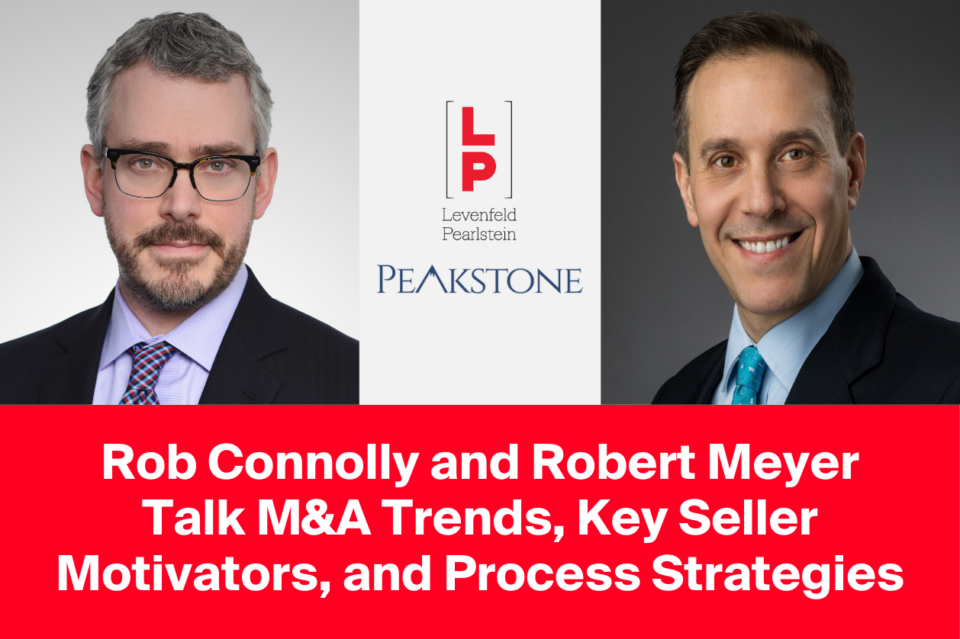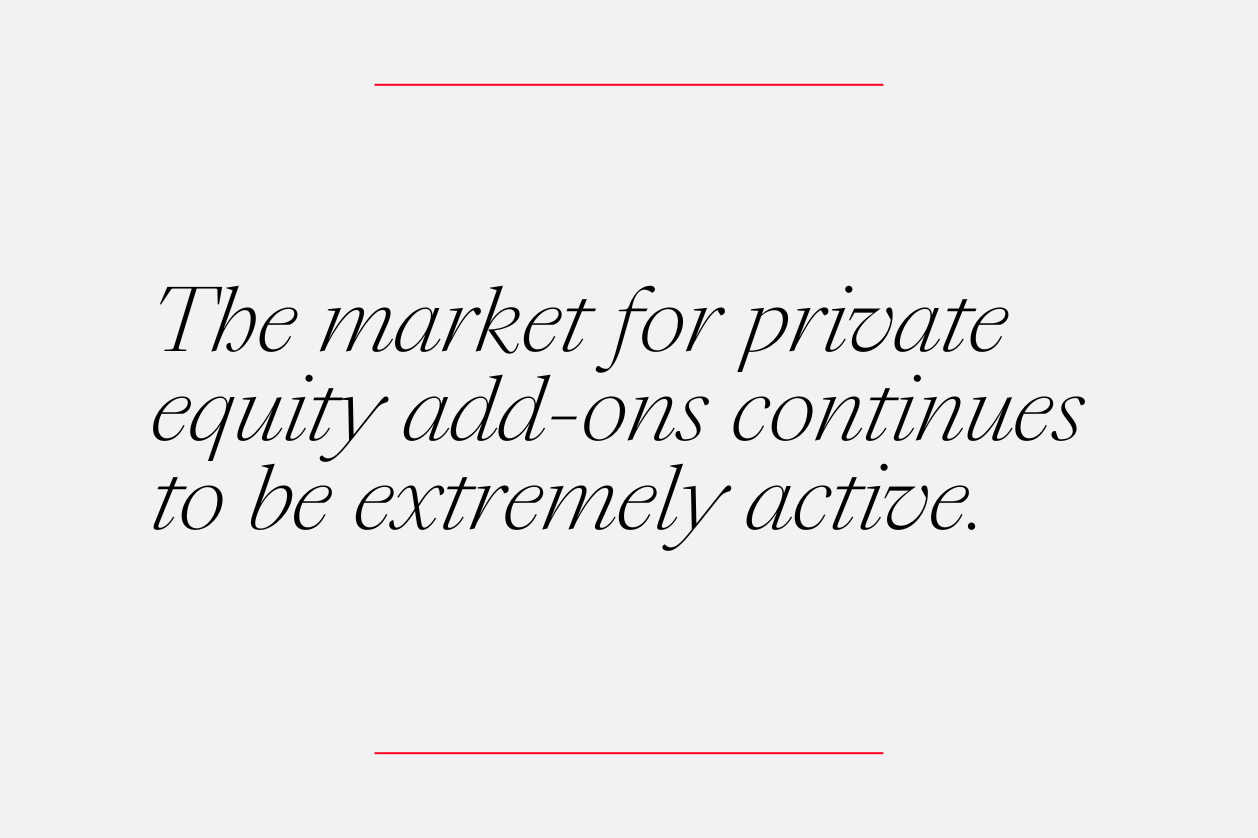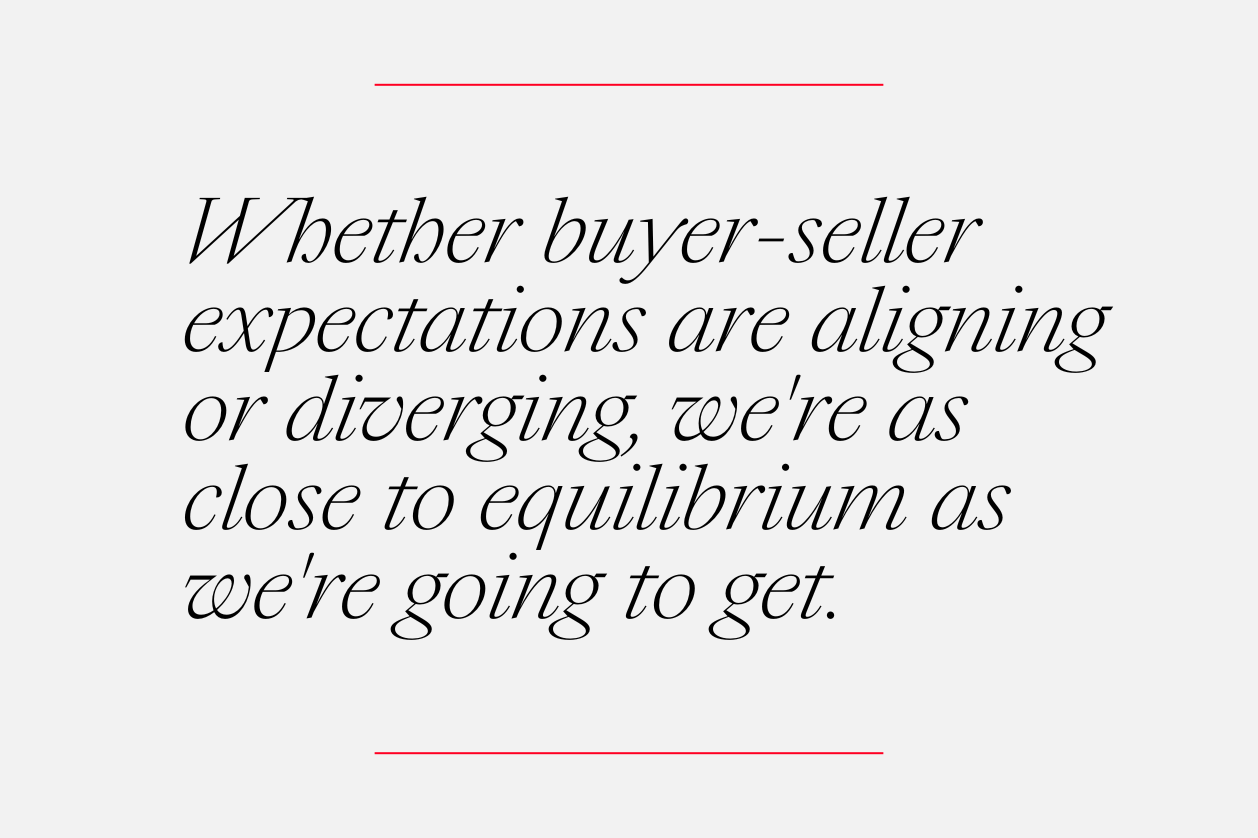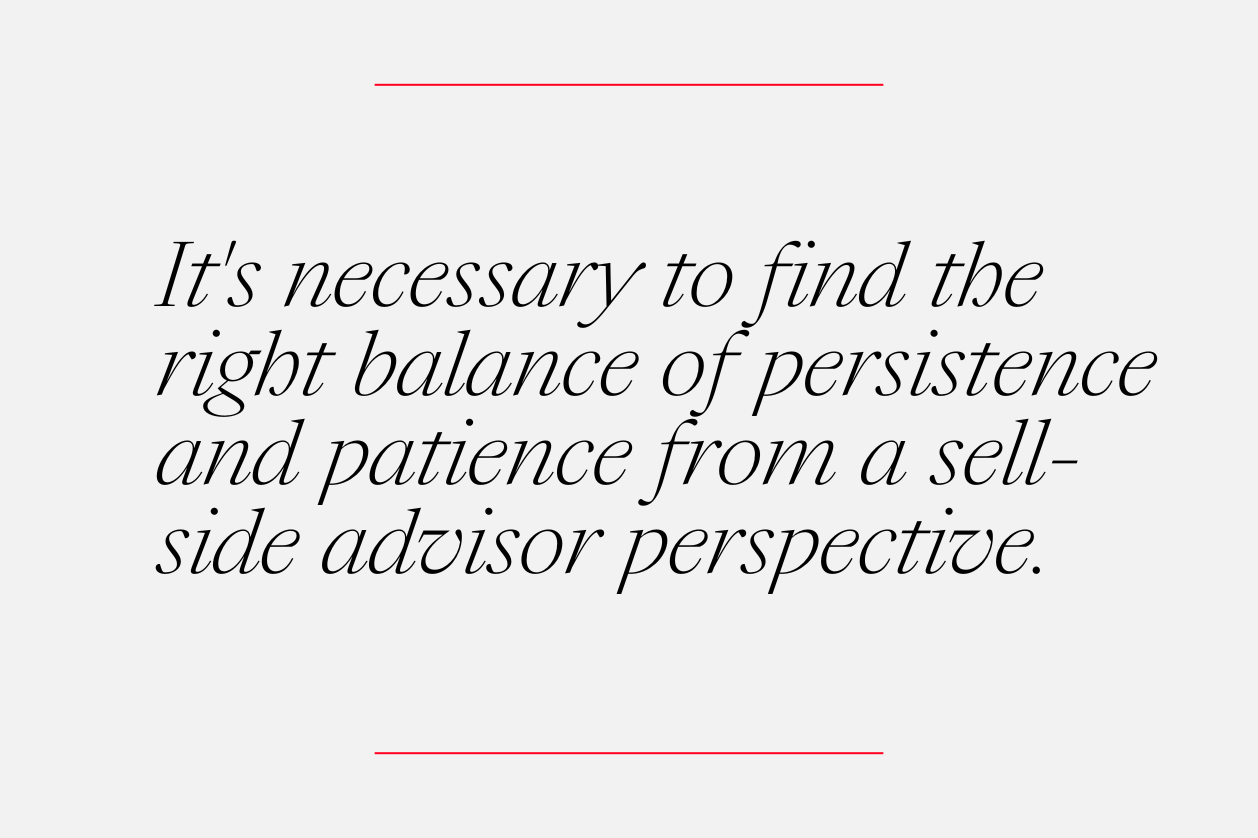M&A Segment Trends, Seller and Buyer Motivations, and Process Strategies: A Conversation with Robert Meyer at Peakstone Group

To help businesses, investors, and deal professionals better understand the evolving M&A market, Rob Connolly – a partner in and leader of LP’s Corporate Practice Group – shares a series of conversations with M&A experts.
Below is his conversation with Robert Meyer, a Managing Director at The Peakstone Group, an investment bank specializing in mergers and acquisitions advisory and raising capital for middle market clients. Robert has over 20 years of investment banking and private equity experience, completing transactions totaling over $10 billion for middle market clients in industrial, consumer, business services, and technology sectors. In this Q&A, Robert shares insights on segment trends, key seller motivators, and advice for sell-side businesses.
The responses below have been edited slightly for brevity and clarity.
How would you describe the current state of the lower middle market M&A environment?
The market is quite strong. It continues to recover from its lows at the end of 2022. Everybody would agree that 2021 was the peak of lower middle market or middle market M&A when everybody was stretched thin. There were capacity issues throughout the system, including at the service provider level and among buyers. It was tough for sellers to get buyer attention, which was a challenge. Activity troughed at some point in 2022 and we’ve been on a slow recovery ever since – a slow and steady recovery, which is good and healthy.
There have been a couple of dynamics driving the recovery. To a certain extent, the recovery from the pandemic took a long time, and it took a while for the pandemic’s impact to be effectively flushed out of the numbers from different perspectives, whether supply chain, raw materials, or pricing dynamics, which lead to earnings challenges and questions around sustainability of profits.
The interest rate environment is another huge dynamic. I think interest rates have peaked and we’re now looking at an upcoming cut, probably several cuts. Once the rate cuts start, it will accelerate the market; the slow and steady recovery might pick up some momentum.
What are key trends you’re seeing in the lower middle market segment?
There are a couple of trends. One, nondiscretionary service industries are good. These are services that a consumer or business can’t put off, such as maintenance, facility services, and home repair. As they say, when your air conditioner breaks, you have to fix it. So, that’s driving the market.
Second, the continued recovery from COVID-19 is also a factor in a lot of situations. If a business had pricing, supply chain, or raw material issues, there were periods of outsized profits. We needed to allow those issues to work through the system to a normalized level of earnings. We’re just approaching that now. If you look at numbers for the second half of 2024, buyers or sellers will find it hard to suggest that those aren’t normalized numbers.
People would look at 2022 and 2023 numbers, say those aren’t normalized, and do what they needed to normalize that. This dynamic created significant issues with buyer-seller equilibrium and value expectations because it all comes back to earnings. We were in a period of inconsistent earnings perspectives. Previously, if you had a $10 million EBITDA business, you’d get a sell-side QoE and a buy-side QoE, and the buyer and seller would battle over a couple of $100,000 of QoE adjustments on a $10 million EBITDA business. But in 2023, we were battling over millions and millions of dollars of adjustments on a $10 million business. A buyer would think the normalized EBITDA was five and a seller would think the normalized EBITDA was ten because we were in a wild pricing and raw material dynamic. That has now thoroughly worked its way through.
Brick-and-mortar industries continue to be a struggle. In real time in the real world, the Amazon Effect is still a question that everyone selling anything from a brick-and-mortar perspective is asking: why and how are you stopping people from just going on Amazon and buying it? That’s another area where services can be helpful, which is the best defense against the Amazon Effect.
What sectors or industries are you currently seeing the most M&A activity in the lower middle market?
It’s pretty diversified. I’m beating a drum here, but everything services-related is very active now. There are several private equity consolidation roll-ups going on in residential services, including everything from HVAC to plumbing to driveways to landscaping to windows to roofing. On the commercial and industrial side, there are facility services businesses and sectors, which include equipment maintenance, equipment repair, refrigeration, compressor repair, general machine, and facilities maintenance and repair. On the commercial side, there’s also landscaping. Outsourcing and IT services are another category of commercial services that continue to be attractive.
Other service categories that are very active, with private equity plays happening, are environmental services and mechanical services. Those are very hot sectors. Medical practices, physician practices, and even veterinary services may have slowed down. There’s been a lot of consolidation, and valuations have ticked up.
What is the current state of financing for lower middle market deals?
The financing markets are wide open, and financing is readily available from multiple providers in the lower middle market. Traditional commercial banks are active in the lower middle market, and depending on the size, the regional banking market has returned to a place where they can be active players.
Non-bank lenders, such as private credit providers, remain extremely active. There are also hybrid providers, which could include groups like SBIC funds, which are really attractive. For instance, we’re in the market right now on a $30 million mostly debt capital raise, and we are wide open with a lot of capital chasing fewer deals with comfortable leverage levels.
Who are the primary buyers in the lower middle market today?
There are two or three different buckets. There are financial buyers and strategic buyers. Within financial buyers, independent sponsors are an emerging group of buyers, but generally, from a financial buyer perspective, you have three types of buyers: independent sponsors, funded private equity groups, and family offices.

From a strategic buyer perspective, there are two categories: strategic operating businesses, which could be privately owned or publicly owned, and sponsor-backed strategics or strategic operating companies that are owned by private equity firms, which continue to be very active. The market for private equity add-ons continues to be extremely active. They’re often considered very high-quality buyers, if not the best buyers, because they have mandates to grow via acquisition. They have full acquisition teams. Oftentimes, their business plans include doing five, ten or even twenty add-ons per year. It’s a fine-tuned machine and they’re running their playbook. As a seller, sponsor-backed strategics can be very good buyers.
Our objective as a sell-side financial advisor, even when we go into a situation knowing they could be one of the best buyers, is to maximize the price in that dynamic. So, oftentimes, that involves putting together a process around possibly one of the best buyers to create competitive attention to induce that buyer to pay the highest price they’re willing to pay. We often talk about the concept of “maximum willingness to pay.” We aim to find a buyer’s maximum willingness to pay, induce them to reveal what that number is, and get them to pay it. Without pressure and competitive attention, they won’t get there on their own.
What are key motivations for sellers?
Often, the key motivation is a family transitioning to retirement. We have many sellers who have been operating the business their whole life. They could be first, second, or third generation. We’re dealing with all of that right now. As they’re nearing retirement age, they want to sell their business, and they might not have a family member to insert in the business who wants to maintain the legacy and take over the business. Other times – and more times than you would think – they do have family members in the business and, interestingly, they just don’t feel like those family members are interested and/or equipped to operate a business. So rather than handing it over to somebody who might put the value at risk, they sell the business, monetize the value, and transfer the wealth or value in a way other than giving them the company.
The other dynamic is like what we saw after the Great Recession in 2008. In those few years, people were so pained by going through that period that when they came out the other side, they wanted to pull the plug and not have to go through that again.
We’re seeing that again post-pandemic. After COVID, people realized that to own and operate a business, they effectively had a large portion of their overall family’s net worth tied to an operating business. There’s a significant risk there and as a business owner, you think that you’re in full control and it’s only going to go one direction, both from an operating and value performance perspective, but then you go through something like COVID and you realize there’s risk. So, you come out the other side of it, you try to get back to where you were, and then decide now is the right time to sell. That’s another key motivation.
We’re seeing dynamics where people are aggressively identifying market opportunities and want to grow. Although we’re talking about motivations for sellers, in this dynamic, it’s folks who are looking for capital partner providers where they may have a small family business they’ve been operating and they’ve identified a couple of target acquisitions that are actionable, and they want to find the right capital partner to continue to grow and build the business.

Whether buyer-seller expectations are aligning or diverging, we’re as close to equilibrium as we’re going to get. Valuation multiples have been reduced since the peak in 2021, primarily driven by the rising interest rate environment. As interest rates go up, if you’re looking at the economic model and the return model for a leveraged buyout, as the cost of debt financing increases, the valuations must come down for investors to maintain the rate of return their limited partners require. So, the increasing interest rate environment clearly reduced the valuation dynamics over the past several years. Sellers had to come to grips with that.
Because the interest rate environment is no longer upward trending – it’s downward trending – we’re in the ideal spot of equilibrium from a buyer-seller valuation dynamic. As sell-side advisors, we can once again use competitive tension to effectively increase what a buyer’s willing to pay because they can be more aggressive.
What process strategies have been most effective to achieve a strong outcome?
We continue to see broad processes as the most successful processes – without question. There has been a trend in the slightly higher end of the middle market where investment bankers like to differentiate themselves by highlighting their ability to run a narrow-focused process. We continue to see broad processes yielding outcomes and results better than what would have been achieved in a narrow process. We know this because the ultimate buyers absolutely would not have been part of a narrow process.
At Peakstone, we have very broad distribution. We can tap into buyers that often would not make traditional focused buyer lists. That could be from a family office dynamic or from some other non-traditional asset managers or institutional investors. There’s so much money and so many investors out there; you never know who is looking to buy or invest in the perfect XYZ business that you’re in the market to sell. So, generally, we like broad processes, and we believe they’re the most effective.
What lessons have you learned from deals that didn’t proceed as planned?

I think the lesson is that it’s necessary to find the right balance of persistence and patience from a sell-side advisor perspective. We’re inclined to have this “run through a wall” mentality where you see a problem and you bulldoze the problem to fix the problem. Everyone knows time kills deals, and you want to move as aggressively and as quickly as possible. Still, we’ve learned that sometimes it takes time for folks to process situations, dynamics, and changes, whether it’s lost customers, lost suppliers, product recalls, or any changes in the market. It takes time for buyers to process that, and I’m not talking about running the numbers through models, but the psychological processing. It’s important to allow them the time to do that, come back to the table on their own accord, and let them come to the right solution rather than jamming it down their throats.
What advice would you give to a company considering selling?
The advice I always give is, when you decide you want to sell your business, you should get out there and start selling it right away. There’s enough that can happen – lost customers, lost suppliers, product recalls, litigation, etc. – that could delay that outcome for several years. When you want to sell, there’s no time like the present to do it.
For more information on Robert Meyer, view his bio. For more information on Peakstone Group, visit their website.
Interested in participating in a future interview series? Please contact Robert Connolly at rconnolly@lplegal.com.
To read other articles in this series, please see here: Insights | LP (lplegal.com)